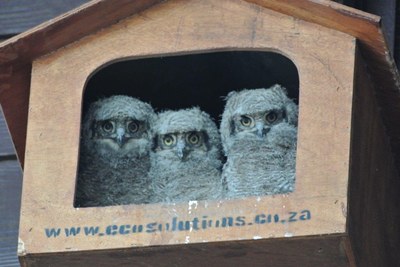Whilst these owls are strikingly different in appearance, both species exhibit many similar adaptations. These adaptations range from their specially designed wings, which allow them to fly silently whilst listening for prey during flight. Light sensitive eyes enable them to detect prey in low light conditions and it is these complex design features that are the basis for the success of the owl as a species.
However, these specialisation means that owls are relatively susceptible to environmental changes and this is where the project comes in. Whilst there is no doubt that there is an Owl population within Gauteng it remains unclear as to how long this will be the case. The key to extracting maximum enjoyment from your owl box is simply INTEREST. Be interested and observant, otherwise, those golden moments and unforgettable interactions will be missed.
The first flights from the box, the youngsters catching insects on the lawn. These moments occur all the time…
 Owls breed from late autumn through summer. However breeding habits are very variable, relying primarily on prey availability and suitable breeding sites, likewise, the number of eggs produced varies dramatically. Barn Owls (Tyto alba) are able to alter their breeding habits in response to prey numbers, the greater the abundance of prey the greater the number of chicks produced, allowing owls to better combat prey population sizes. This is exceedingly useful in controlling populations prone to growth explosions i.e., rodent and insect species.
Owls breed from late autumn through summer. However breeding habits are very variable, relying primarily on prey availability and suitable breeding sites, likewise, the number of eggs produced varies dramatically. Barn Owls (Tyto alba) are able to alter their breeding habits in response to prey numbers, the greater the abundance of prey the greater the number of chicks produced, allowing owls to better combat prey population sizes. This is exceedingly useful in controlling populations prone to growth explosions i.e., rodent and insect species.
During the period in which the owls breed activity is centred around the box. Food exchanges and vocalisation is common and is a key indicator of breeding activity, this is the most exciting period. The owlets leave the box approximately 4-5 weeks after hatching, however, they are poor fliers and very curious which enables one to observe them closely. Youngsters are inclined to perch close to the ground and exhibit all the playfulness of young kittens and watching them play on the lawn is a truly unforgettable experience.
During the remainder of the year, the box will see less activity, although once owls have bred in the box the will continue to utilise it year after year. The owls will remain in the vicinity in order to protect their territory of which the box is an important component.
Spotted Eagle Owls (Bubo africanus) and Barn Owls (Tyto alba) each produce distinctly different calls. Have a listen to our sound clips below.